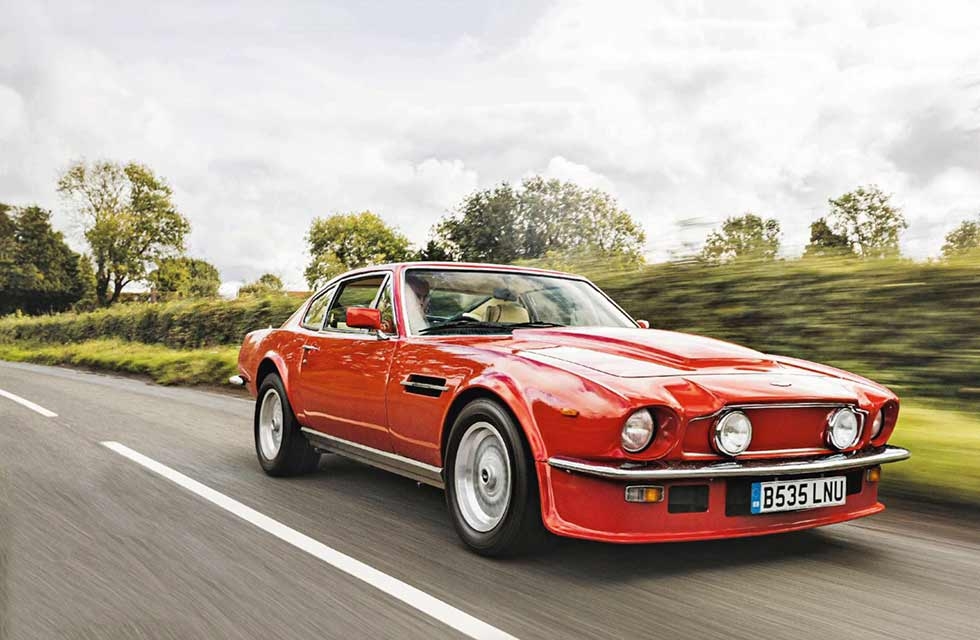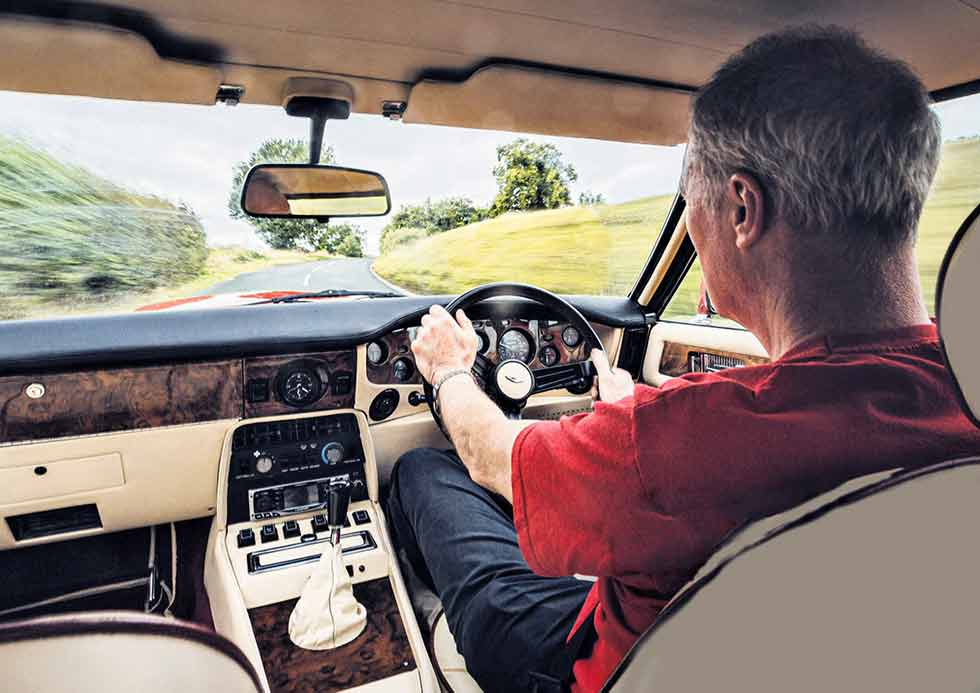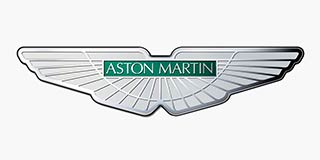
Reader dream Aston Vantage drive Mark Ward likes striking style, British pedigree and V8 power, so we arranged for him to spend a day behind the wheel of a 1985 Aston V8 Vantage. Will it prove a tailor-made fit? Words Emma Woodcock. Photography Rob Cooper.
‘It’s special to be Behind the wheel’
Reader Mark Ward meets the Seventies’ fastest accelerating supercar of all – the Aston Martin V8 Vantage
The List Your dream drive made real
The List We put a shellshocked reader behind the wheel of Britain’s first supercar – the Aston Martin V8 Vantage. Will his (and our) bravery hold out?
A mystique hangs over the Aston Martin V8 Vantage, even now. Released in 1978 to cries of, ‘A true great’ and ‘Britain’s only supercar’, the substantial coupé makes a virtue of its extravagance but leaves drivers to guess at its most impressive figures. Newport Pagnell has never officially provided the UK market with horsepower or torque outputs for the mighty 5.3-litre V8. Today, Mark Ward, the current owner of four British bent-eights, is about to tear away the shroud and discover just how potent a quartet of 48mm Webers feels on the open road.

For Mark, it’s a dream come true. ‘I was a young man back in the early Eighties and Aston Martin was iconic, but the DB5 Aston and other earlier models just felt like old cars to me then. In comparison, the V8 Vantage just looked a bit brutal and had an air to it. There were a lot of mundane cars around in those days, so seeing a Vantage was something really special!’ Walking through the workshops and show-rooms of specialist Stratton Motor Company, he can relive that experience time and again. There’s a 1987 X-Pack Volante convertible to peruse, while another corner boasts both a hardtop X-Pack and the uncluttered lines of a lesser V8 saloon.
‘It will happily trundle around at 20mph – but you want to use the capability of that engine’

‘It’s like being a little boy in a sweet shop,’ he grins. Yet none of these machines are the focus of Mark’s excitement. With the help of firm founder and long-established Aston Martin specialist Roger Bennington, we’re picking a path to a small outbuilding and the Storm Red 1985 Vantage within.
A first glance doesn’t disappoint. Dressed with the revised front air dam and wider wheelarches that appear on Vantages built from the mid-Eighties onwards, this Series II example pulses under low garage light. Approaching from the rear, Mark is drawn straight to the upturned bootlid. Unlike the Series I Vantage, which uses a stubby, high-rise spoiler that on the very earliest cars is bolted into place, the 1985 car exhibits a smoother but still distinctive upkick.
‘It’s a car that is not only designed to go fast but also one that looks fast too’
Says Mark, ‘The wing is something I’ve noticed straight away, and I actually prefer it to the earlier version. It’s been styled into the car and it just looks the part.’
Snapping a quick shot of the intricate 16in Ronal wheels, Mark muses on the model’s width and its importance to the Vantage look. ‘The wheels look magnificent – though they’d probably take some cleaning – and used to look so much bigger than any ordinary car. You’ve got the flared wheelarches too. Put those two together with the blanked-off grille – which really differentiates it from other V8 models – and you’ve got a car that’s not only designed to go fast but one that looks fast too.’ Two inches wider than a V8 Oscar India, the Vantage has an imposing physical presence. ‘It’s a departure from the DB4, DB5 and DB6 that came before. They were beautiful cars but the Vantage is less… tweedy.’
The time comes for a familiarisation drive with Roger, who sold dozens of Vantages when new and knows the model intimately. He talks Mark through the model’s foibles, advising a steady throttle application if the car won’t start on the key alone and counselling a double-declutch from first to second when cold, before spearing into the Norfolk countryside for a quick demonstration. ‘You can tell he’s comfortable in the car,’ notes Mark with a chuckle. ‘He’s sticking his foot down and using the gearbox too!’ Roger hands over the key and the Vantage is Mark’s for the afternoon.
Combining Connolly hide with blood-red Wilton carpets, the cabin reflects the quality-oriented philosophy of Aston’s then chairman Victor Gauntlett. Black hide coats the dashboard – replacing the plastic used in earlier examples – while the seats are piped red to match the exterior and cream leather covers everything from the gearstick gaiter to the headlining. Notes Mark, ‘It’s a very traditional car and the burr walnut dashboard is beautifully done, though the Smiths gauges are very familiar.
‘The Vantage already feels like a supercar you could live with every day. It’s very comfortable and useable. You could even get two adults in the back for a short drive. The front seats are quite upright and I like that. You’re not lying down like you would in an Italian supercar and the view out is good, which is a surprise.’ The starter churns and churns, seemingly without hope or end, until the motor finally catches with muffled thunder. Mark pulls back the fly-off handbrake, lets the lever fall away and drives off.
Before we even leave the car park, the vista beyond the windscreen grabs our attention. ‘You’d think it would be an air scoop,’ says Mark, pointing to the bluff-shouldered wedge that rises above the bonnet, ‘but it’s completely sealed and it’s only there to clear the carburettors. It looks a bit brutish and it really suits the car.’ The nose – and the noise – soon clear a space in the traffic and the Vantage burbles south along the Pye Road.
‘It’s a bit intimidating to be driving this car,’ Mark comments as, beyond the fast-fogging windscreen, the traffic slows to stationary. ‘But it feels very special to be behind the wheel of a classic Aston Martin.’ His early anxieties centre around the clutch pedal, a floorhinged design that sits in a close-set footwell. ‘From the moment I first put my foot on the clutch, I’ve noticed how heavy it is and I’m wondering whether I’ll be able to change gear effectively. The pedal is quite close the brake too; I’ve got size 12 feet, so I’m a little worried that I’ll hit both of them at once.’
The narrow, mud-soaked path along Stratton Road does little to allay Mark’s worries. Tense and cautious, he’s yet to find a rhythm with the car. ‘Do you pull to the side and let people past or do you believe there’s enough room for us both to come through?’ he asks. A jink onto the flowing and better-sighted roads towards Great Moulton removes that stress. ‘It’s easy to position the car; there’s not too much feel but the steering doesn’t feel over-assisted at all. The weight is perfect for me.’
Temptation swells with familiarity and thoughts turn to the V8. ‘You do have to poke the accelerator to get moving but it’s nothing untoward. This car is clearly well looked after – four Webers must be very tricky to keep in line but it will trundle around at 20mph without complaint. It’s difficult to keep it there, though – you want to use the capability of that engine!’ A longer straight appears; Mark cracks the windows and the rear-view mirror empties.
‘Provoke this engine and it sets off at a rapid pace, but the power and the noise feel modern and it’s not at all like an American muscle car. The Vantage feels civilised, yet whichever gear you’re in you can put your foot down and it goes.’ These uncategorised roads are still too bijou for a grand tourer like the Vantage, so the hunt begins for wider tarmac. ‘The Aston feels fast on windy country roads like these,’ he agrees. ‘I think you’d really need a solid A-road to understand the Vantage.’
Rural Norfolk won’t provide that, but fast, well-surfaced turns leading away from nearby Forncett Saint Mary beckon. On the way, Mark focuses on making smooth shifts with the five-speed ZF manual gearbox. ‘You have to be very precise, especially from first to second, and the lever has to go straight into the specific gate. It’s quite a close-set pattern and you can easily put it in fourth instead of second. More modern gearboxes might be narrow-set but it’s a lot easier to find the gears, while older cars like my Triumph Stag put the gears a lot further apart than the Vantage.’
Spacing isn’t the only challenge presented by the transmission – it has a dogleg arrangement which puts first left and back. ‘I’ve been driving for 30 years and everything else I’ve tried has a conventional gear layout,’ Mark laughs. ‘I’mnot always sure which gear I’m in, but the Aston has huge torque to compensate. You could just drive it in third if you wanted.’ That might be possible, but Mark won’t be beaten and his shifts gradually get smoother. ‘You need to be firm but gentle and you have to guide the shifts; you can’t just jam it into a gear. With time, I think it could all be overcome and I could get to be very good at changing gears.’ ‘I was expecting a more brutish car and one with a lot more peculiarity,’ Mark adds. ‘The brakes feel very natural; nothing about them surprises.
You hear that some older supercars need the driver to stand on the pedal, but the Vantage feels relatively modern and capable. The discs are almost as good as the ones on my new Audi A6 company car.’ At a cruise, the ride doesn’t force the driver to compromise either. ‘It’s very compliant and a comfortable place to sit. The Vantage absolutely comes across as a grand tourer; you could drive it to the south of France and arrive feeling fairly fresh.’
With shallow crests and lazy sweeps now beneath the Aston’s 255-section tyres, the pace rises but the Vantage never loses composure. ‘The wheel isn’t writhing around and the chassis doesn’t tramline over the bumps. While still being able to drive relatively fast, I want a bit of compliance for the public road and the Vantage’s handling is exceptional. It’s up to the performance of the car and exactly to my taste.’ Rolling into turns with fluid inputs, it’s clear the steering suits Mark too. ‘The response rate is about right and it doesn’t change with speed. The weight does, though; the faster you go, the lighter it becomes.’ It all builds confidence and Mark is soon making assured, consistent inputs.
‘As I get more used to the car and when to change gear, the power available really becomes apparent,’ he continues. ‘There’s a surge and driving up to 4000rpm is enough to show its true worth. There are so many modern sports cars that can offer this performance, but you have to look at the Vantage in the context of its period. It’s a beautiful car, a brutish car, a big car and a fast car.’
Falling into tight turns and densely-wooded straights, Swan Lane allows Mark to explore the engine’s other great virtue – its ululating, baritone battle cry. ‘I’ve got to put the windows down on a road like this. I like noisy cars – I put a sports exhaust on my Jaguar XK8 and a straight-through pipe on my TR8 – and that’s the boy racer in me. The Vantage is subdued when we’re cruising, but put your foot down and it makes a wonderful noise which only improves at higher revs.’ Cultured yet insistent, the note mixes with the acceleration to get Mark smiling for miles.
The light is failing and the road leads back to Stratton headquarters, the exhaust noise thudding against the walls as we enter the workshop. Mark removes the key and shares his final thoughts. ‘This is a beautiful, wonderful car and today has been a great experience. The Vantage is a lot more capable than either of my Triumphs, yet it provides its power in a way that’s more old-fashioned than my Jaguar XKR. For me, that makes it the best of both worlds and almost perfect. I’d be proud to own any vehicle like this. The Vantage still has a place in my dream garage.’
1985 Aston Martin V8 Vantage
Engine 5340cc V8, dohc, quad Weber 48 carburettors
Max Power 380bhp @ 5800rpm
Max Torque 380lb ft @ 4000rpm
Transmission Five-speed manual with limited-slip differential, rear-wheel drive
Steering Rack and pinion, power assisted
Suspension
Front: Independent with wishbones, coil springs and anti-roll bar
Rear: de Dion tube with Watt linkage, coil springs and trailing arms
Brakes Servo discs front and rear
Weight 1800kg
Performance
Top speed 165mph
0-60mph 5.3sec
Fuel Consumption 10mpg
Cost New £57,000
Asking Price £265,000
Burr walnut dash and brutal bonnet bulge attracted Mark’s attention.
Cream Connolly hide clothes the majority of the opulent interior.
Switches lifted from the Seventies Jaguar parts bin.
The 5.3-litre V8 with quad Webers weaved its magic on Mark’s ears Mark’s T-shirt failed to predict the Aston’s dogleg gear pattern. Mark mastered initial fears and enjoyed the Vantage advantage.
MARK WARD’S CAR CV
Big-engined Brits and an odd French incursion
TRIUMPH STAG
‘This was a beautiful-looking car, it sounded fantastic and was something exotic in 1980. The head gasket went after 18 months, I met my girlfriend (now wife) and sold it in bits.’
CITROËN DYANE
‘I bought an Austin 1100 and didn’t like it, then saw the Dyane for £160. With some welding and resprayed wheels it took us to France four-up. Why France? Well, the locals may have been able to fix it if it broke!’
TRIUMPH STAG
‘I saw my first Stag on the owners’ club stand an event in Cheshire and decided I needed to buy another. I bought my current Stag less than four weeks later and we’ve been all over in it.’
TRIUMPH TR8
‘My wife and I owned a TR7 in the Eighties; everyone was doing eight-cylinder conversions, which lit a flame. I went to see this one just before Christmas 2015 and I’ve since refurbished the interior and rebuilt the suspension. It scraped along the ground when I got it!’
JAGUAR XKR CONVERTIBLE
‘I’ve got an XK8 coupé too, but needed the supercharger to really get the full benefit of the model. It’s almost silent and so fast you have to be careful. With 370bhp, it’s a genuine supercar.’
MARK’S DREAM DRIVE LIST
Jaguar E-type
‘The iconic Brit. It went fast and looks fast. They’re worth all the money people pay today.’
Aston Martin V8 Vantage
‘A British muscle car that has hand-built heritage to match.’
Lotus Esprit V8
‘Finally the car had the engine it deserved! A beautiful piece of engineering.’
TVR Chimaera
‘It’s the leather, the dash, the fact it’s a real sports car. And the thunderous noise.’
Alfa Romeo Montreal
‘Alfa playing in the big league with a V8 supercar from the days when they were in F1.’ Triumph 2.5 PI ‘Sounds wonderful; and few other production saloon cars had fuel injection back then!’
Dino 246
‘My teacher’s father owned one and used to drive it to school. More recently, a vigorous passenger ride at Loton Park more than lived up to expectations.’
Bentley Turbo R
‘The Turbo really relaunched Bentley and I thought about buying one a few years ago.’ Aston Martin Lagonda ‘I know it’s a bit Marmite but the saloon still looks and sounds fantastic.’
Chevrolet Camaro
‘The first car of any real power I travelled in, from Heidelberg to Exeter around 1970.’






